By Samantha “Kitten” McComb
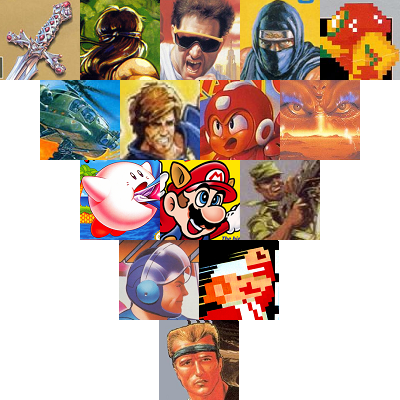
– – – – – – – – – – – – – – – – – – – – – – – – – – – – – – – – – – – – – – – – – – – – – – – – –
Bear with me as this article begins. I need to get the stale introduction out of the way before I delve into how this bit of writing is personal and heartfelt, rather than another sterile look at the hits everyone’s already familiar with.
My very first video gaming console was the NES. It was what i grew up on, it is where the development of my taste sprang from and it is where I hold the fondest memories of my experiences gaming. The NES is somewhat of an icon in gaming culture, and is often looked to as the system that saved the hobby. Many classic series that are still held in high regard to this day owe their humble beginnings to the NES. The platformer genre, perhaps the most highly regarded classic gaming genre, is regularly considered to have flourished in its golden age during the lifespan of the grey box.
Almost anywhere you see a gathering of people invested in the culture, you see people wearing clothes or accessories with things like the NES or the original NES controller controller on them. Shirts with NES sprites are considered hip and cool, and showing your love for “old school” Nintendo has become commonplace. NES game prices continue to rise online, and gaming culture, in general, has become increasingly nostalgic toward the console, idolizing it as it as “the good old days.”
As with any culture fixated on entertainment created in the past, good discussion and genuine appreciation become difficult to find. You get the grumps that either despise anything mainstream or believe that those who didn’t grow up with it can’t love it, the kids desperate for identity, the serial abusers of emulation tools that have never played a game straight, the nerds drowning themselves in nostalgia, the hipsters in it for the scene, the collectors, the youtubers, et cetera. While everyone is going to exhibit some of these qualities some of the time, many are eager to willingly characterize themselves by it to fit into a clique or niche.
This desperation to borrow bits and pieces of pre-established identity fouls discussion and taints appreciation. It stops being about the games and hardware and turns into an echo chamber of regurgitated opinions. Phrases like “Nintendo hard” become memes overwriting critical thought, and people look to become part of a collective rather than establishing their own ideas and beliefs. It’s easy to get sucked into becoming a product of the lowest parts of the culture, rather than contributing to its growth and vibrancy.
So, what is a genuine appreciation of the NES? I believe that it’s any sort of appreciation that you come up with on your own. Tempered with experience and dedication (of all shapes and sizes), I believe it is a foundation to good writing and discussion.
I love listening to or reading material by people that love the NES and its extensive library of games. While I appreciate games from all generations, the NES has proven time and again to be the one console that always fascinates me the most. I enjoy contributing my own writing to the pool that exists in discussing it, and I enjoy adding my own personal appreciation into that writing.
I take a lot of pride in expressing bits and pieces of my identity into my writing on games, and this piece is meant to be a bit less critical than most of what I do, focusing a little more on my personal history. All 15 of these games, whether I played them in my childhood or not, have come to epitomize what I think of when someone says “NES.”
Keep in mind while you read that this is by no means meant to be an authoratitive guide to the definitive NES experiences, but merely one person’s stance on the games she believes to define a generation, for her, and how they continue to do it.
– – – – – – – – – – – – – – – – – – – – – – – – – – – – – – – – – – – – – – – – – – – – – – – – –
Metroid
Metroid is one of a few games here that I didn’t actually grow up playing. Although I was heavily invested in both Metroid II and Super Metroid, I only ended up playing Metroid for the first time years later when they released it as an unlockable on Metroid: Zero Mission. At first, I hated it. It was unforgiving, had no map at all and progression through the game went at a sluggish pace that was incredibly difficult to appreciate after being spoiled by modern design guiding you through every little bit.
However, the more I played, the more I came to appreciate and eventually enjoy it. It’s a game rich with atmosphere that is heavily entrenched in trying to bring out the player’s sense of exploration. You aren’t meant to find all of the items and the lack of a map means to suggest the player experiment with ways to keep track of their location on their own. It is a game where notes are meant to be taken and discussion of how to progress and where to find secrets is encouraged.

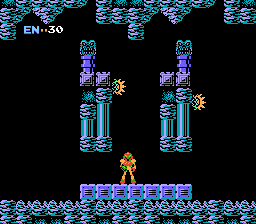

Players today feel cheated when they do not beat a game and cannot get every item, and games today coddle that sort of mentality. Metroid is a game that requires you to remove yourself from that line of thinking and savor its slow pacing over a long period of time, and I know the rhetoric is tired, but it’s true: games today could really learn a lot from that.
Though I grew up more on the two sequels, I still find it worth mentioning that I feel Samus played a role in me coming to terms with my own gender identity. Where I grew up isn’t exactly somewhere people might consider “progressive,” and having a strong female role model in a game that I could attach my own experiences and identity onto was great. This was especially true considering that the early Metroid games did not have the constant and overbearing text/subtext I got from everywhere else, both in games and in real life, that told me (and still tells me) that women aren’t allowed to like or do things that are “for boys.”
– – – – – – – – – – – – – – – – – – – – – – – – – – – – – – – – – – – – – – – – – – – – – – – – –
Ninja Gaiden
I got into the Ninja Gaiden series only about five years ago, and it was one of the first series I dug into when going back to explore the vast amount of the NES library that I had missed out on. Although the narrative wasn’t really anything to write home about, it’s a series that is perhaps most noted for being one of the first to really popularize the use of cutscenes to tell its story. Said cutscenes aren’t particularly impressive by today’s standards, but they still make the series stand out among other titles in the NES library as noteworthy.
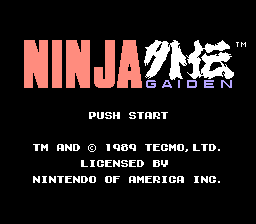
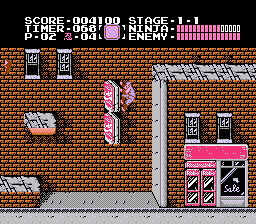
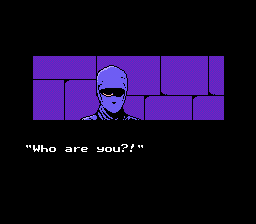
What really makes Ninja Gaiden such a standout title to me, however, is probably how it is most flawed – in its horribly difficulty balancing. Some enemies have incredibly cruel movement patterns, like the eagles, you end up sticking to walls when you don’t want to and can’t climb them, and the enemy spawning system is really poorly implemented. If you kill an enemy on the edge of the screen, it’s possible it will respawn without even scrolling the screen. Although this is hardly a problem early in the game, it becomes a nightmare once you reach the final stage (which lasts longer than the entire remainder of the game on your early playthroughs given its outrageous difficulty).
One of the biggest reasons I love the NES so dearly is because a considerable portion of its library is difficult, but fair. For every game that is considered fair, though, there are several that aren’t. Telling the difference can be a big obstacle to overcome for a fledgling fan of the console, and Ninja Gaiden is really the title that people get most muddled on, myself included. I love every entry in the series, but I always recommend the second over the first for being a much more mechanically satisfying game.
– – – – – – – – – – – – – – – – – – – – – – – – – – – – – – – – – – – – – – – – – – – – – – – – –
Shatterhand
Shatterhand is a game that I feel has come to truly epitomize the “spirit of the NES game.” It plays somewhat like a mix between Ninja Gaiden and Mega Man, it’s visually one of the most impressive looking NES games with plenty of effects and detailed levels and enemies, its music sounds as though it could belong to any great game from the era, and its overall presentation outright bleeds “early 90’s.”
The premise is that the protagonist is an ex-cop who had his arms crushed in the line of duty. Having his arms replaced with cybernetic limbs that can punch bullets, he dons some awesome shades and a green vest and gets right to work on setting the bad guys straight. Shatterhand’s Japanese counterpart is a licensed game based on some sentai-esque thing, and I’ve always intentionally left it a mystery as to which came first.
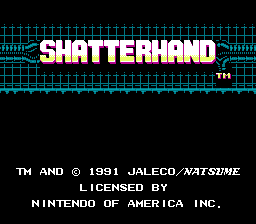
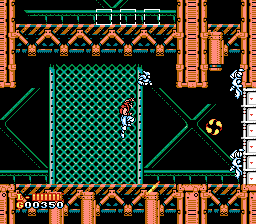
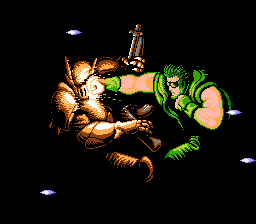
Shatterhand’s manual is full of enthusiasm for both the game and the publisher… Everything about the product is a relic of its era, and I mean that in the most flattering way possible. For whatever reason, perhaps due to a late release, Shatterhand went mostly unnoticed and has received extremely little exposure despite its excellent production values, satisfying design and qualities that most people nostalgic for the NES tend to pine after.
While I didn’t play Shatterhand growing up, it definitely made me feel like a kid again. Perhaps best enjoyed with a bowl of your favorite cereal and either before or after watching some cartoons, it is truly a game that embodies the meaning of what was “cool” to a child of that generation.
– – – – – – – – – – – – – – – – – – – – – – – – – – – – – – – – – – – – – – – – – – – – – – – – –
Castlevania
Although I consider the third game to be the best of the three on the NES, I have to say that the original Castlevania is almost objectively much more distinct, important and influential. It has long been one of the most successful action-platforming series, and I feel like when you divorce first-party titles from the equation, NES enthusiasts have always been divided over which they feel is the better series on the console – Castlevania or Mega Man?
I didn’t get too heavy into the rivalry as a kid, but I definitely stuck with my guns (mega buster) and kept playing my Mega Man games. When I was finally convinced to give Castlevania a try after hearing so many good things about it, I played the N64 game mistakenly believing that was the one everyone was talking about. Needless to say, I wasn’t particularly impressed, and it wouldn’t be until years later that I really gave the series its fair shot with Symphony of the Night, which had been the actual game everyone was discussing, back then.
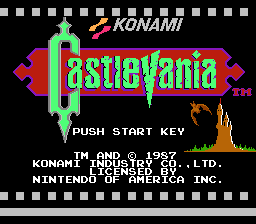
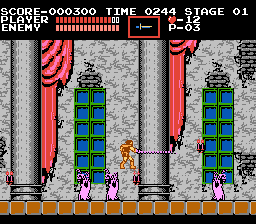
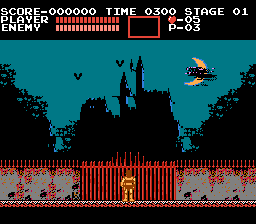
When I finally got to playing the original after craving more with the end of SotN, there was a distinct charm it had that I really took to. I always felt that the 90’s had some weird obsession for “classic” monster villains like Dracula, Frankenstein and mummies, and Castlevania really embodied this fetishization in about as nostalgic a way as something could for me – in an NES game. They really crammed about every kooky horror cliche they could into the game, even going as far as to make the title screen look like it was on a strip of film, and it’s a shame they didn’t have a Castlevania breakfast cereal.
Going beyond just the theme, it’s a rock solid game and one of the best action-platformers ever made. Both aesthetically and functionally, it’s lovingly crafted and makes an immediate impression on the player just with its brief opening. The series has since really been all over place, but the very first entry has really stood the test of time and proven itself an incredible foundation.
– – – – – – – – – – – – – – – – – – – – – – – – – – – – – – – – – – – – – – – – – – – – – – – – –
Zelda II: The Adventure of Link
I first played this one early on in middle school, just as the internet was really starting to get big and sites like GameFAQs were rolling into the limelight (at least, that’s how it felt, to me), but before I had really started using them. It was around the time the N64 had been released. My mother worked part-time at a sign shop owned by a friend of hers, and her daughters’ no-longer-played NES had been left in a little break room along with an assortment of cartridges, some of which I’d never played.
I’d often end up there for an hour or two after school, and I’d generally play Zelda II, Life Force, The Guardian Legend or The Goonies II. At this time, I was still really terrible at most games, among those I was worst at included adventure games and shmups. These games happened to be one, the other, or even both. I suppose that you could say a sense of curiosity encouraged me to keep at them, but I never got very far in any of them.
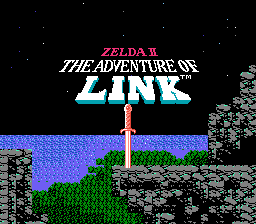

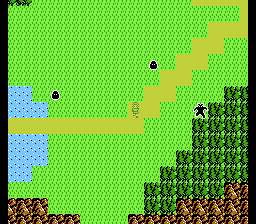
I went back to Zelda II several years later and ended up completing it with the help of a guide, something I’ve come to regret doing, since. What I regret even more is not being able to play this game back when it was a big deal, back when people would get together at the lunchtable and discuss their progress and the location of secrets. I never got into adventure games at a young age, and it’s forever been something I feel like I kind of missed out on.
I’m not trying to say that Zelda II’s cryptic nature was all great, but with the introduction of let’s plays, gaming guides and all the information overload of the internet, I feel like game design was changed for the worse to miss out on the satisfaction of gradually completing something over a long period of time and with the help of friends. It’s hard to find a game where discussion of secrets and elusive late-game areas actually feels rewarding, anymore. Zelda II was a flawed game, but I still genuinely admire its sense of adventure.
– – – – – – – – – – – – – – – – – – – – – – – – – – – – – – – – – – – – – – – – – – – – – – – – –
The Guardian Legend
As just mentioned, I first started playing The Guardian Legend around the same time I started playing Zelda II. Where Zelda mostly kept me from getting any further due to its more cryptic nature regarding progression, The Guardian Legend held me back by its difficulty. I had never been any good at or owned a copy of any shmup other than Silk Worm, which I’m pretty sure I’d never even gotten within three levels of beating in all the hours I had played it with my father.
What kept me interested in The Guardian Legend more over Life Force (which I’ve since come to believe is the better of the two games) was that it was a creative mix of genres, both an overhead, Zelda-esque adventure title and a difficult, vertically scrolling shooter. The overhead segments felt a lot easier than the shooting segments, and I spent a lot of my time playing the game just wondering around the overworld. I was mostly content to do so, even though I felt constantly teased by my inability to get any further than past a few of the shmup levels.
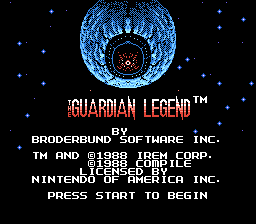
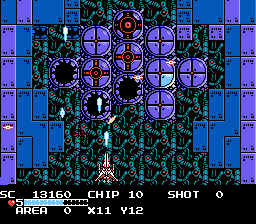
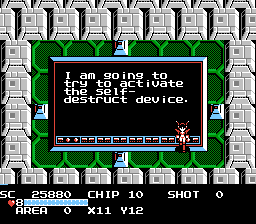
What made this game stick out to beyond it essentially being two different games is that it planted that seed of really wanting to go back and get better within me. Difficulty in video games today can largely be brute-forced with minimal effort and maximum time consumption – The Guardian Legend is one of many NES games that demonstrates design principles insisting the player better themselves rather than just throw their weakest efforts at a problem over and over again.
– – – – – – – – – – – – – – – – – – – – – – – – – – – – – – – – – – – – – – – – – – – – – – – – –
Mega Man 6
Mega Man 6 is a game that I feel really gets the short end of the stick from a lot of fans of the series. A lot of the criticism is admittedly justified – I mean, the difficulty is way too easy, the robot masters kind of feel like they’re reaching a little too far, so and and so forth – but I feel like people are too eager to dismiss it as “rushed” or “crammed” due to its position at the end of the NES life cycle and being the last in the series on the console. People had pretty much had enough Mega Man at the time, and these days it tends to be played the last in a marathon of games when people are really starting to get worn down.
I grew up in love with most anything Mega Man, and 6 has always held a special spot in my heart largely because of its high production values and the utility of its two new Rush adapters. Both the jetpack and the power adapter are an absolute delight to use and there are loads of things you can do with either of them. Yeah, the jetpack can strip away a lot of the platforming difficulty in the game, but I don’t think there’s necessarily anything wrong with that given the amount of situations it’s useful in and the fact it does still posess a bit of risk and reward.

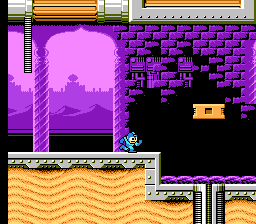
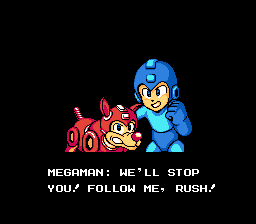
When you’re jetting around, you can’t charge your shots, you can’t slide while on the ground, and you’re still vulnerable to taking a hit and falling in a pit. The last of those doesn’t sound quite as dangerous considering that you can just fly over the pits, but that’s not taking into account that this subtly urges the player to get themselves in over their head. Get a little too hasty or haughty and you will end up paying for it, and I tend to have an admiration for game mechanics like these that players will contruct their own downfall in trying to abuse.
The power adapter, on the other hand, turns Mega Man into a powerhouse, but at the cost of having a short range and an inability to slide. If you bother to play using the power adapter enough, you’ll get to see it has unique effects on certain enemies (such as making them fly back into wall) and can often hurt or even instantly kill enemies that are otherwise invulnerable with a charge shot (you can kill a met with its hat down, for example). When you’re fighting the Mr. X boss, hitting him with a charged shot will actually cause him to change direction mid-swing, as if the force of your attack pushed him back.
It’s not the best of the NES Mega Man games, but I personally rank it second to only one other. Despite most elements of it falling short of other games in the series, they’re all still at high standards and the adapters really offer a fresh new way to play the game that makes it stand out from the crowd, at least to me.
– – – – – – – – – – – – – – – – – – – – – – – – – – – – – – – – – – – – – – – – – – – – – – – – –
Bionic Commando
When I was but a wee lass, I checked out the Bionic Commando “Worlds of Power” book from the elementary school library and read through the whole thing. Whether my feelings were genuine or just inspired from the pure awe at reading a book about a Nintendo game, I thought it was super cool and just had to play the game. Months later, Mom would take me out to get a game from a pawn shop, and there I found it. I was going to do it, I was going to live the experience I had read all about.
There was just one problem – you couldn’t jump! This completely blew my mind, and I ended up playing it for something like an hour or two without even getting to the boss of the first level. You couldn’t even continue, either, and you died in just one hit (of course, I later discovered you had to earn additional hit points and continues, and it was actually pretty easy to do). Who would make a game this sadistic? I ended up taking it back and returning it for another game, and the name Bionic Commando ended up being retained as a somewhat grudgeful memory.
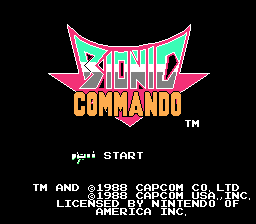


Many years later, I’m full-fledged back into classic gaming and the recommendations to play Bionic Commando are constant. I emulate it and give it another shot to see if it’s worth buying, and I still can’t stand it. Bionic Commando: Rearmed is announced, and I decide here and now I’m going to buy and play the remake to the end to finally try and get into this series. Although it starts out a little rough, I really find myself getting into it and end up loving it so much that I’m one of the very first people to beat the notorious Super Hard difficulty.
I go back to the NES game again and, finally, everything clicks. I end up beating it over and over again and finally “get” what everyone was talking about. One of the things that has truly bolstered my admiration for the NES over the years has been having moments like these where I go back to and appreciate something I just did not understand as a kid. The NES has such a diverse and interesting library that I feel you can keep going back to it over literal decades and find stellar new experiences both in games you’ve placed and ones you’ve never really dug into, before.
– – – – – – – – – – – – – – – – – – – – – – – – – – – – – – – – – – – – – – – – – – – – – – – – –
Silk Worm
I couldn’t, in good conscience, make a list like this without having at least one game on it that is if not bad, at least pretty darn mediocre. As I’ve already said, Silk Worm was my very first shmup, and I used to play it all of the time with my father. We’d sit down and decide who got to use the NES Advantage this time, and then who got to be the helicopter or the jeep and just play it until we ran out of continues… Which honestly never took very long.
Playing it today, it’s very easy to evaluate it as a game that’s barely even worth playing. As a kid, however, I always thought it was so darn cool. Probably one of my earliest examples of beginning to obsess over “the boss fight,” Silk Worm had some end stage bosses that were really intimidating and incredibly satisfying to take down. Every time you got to one, a warning sound would play as the screen flashed and turned black, then the big bad would slowly roll onto the screen with its glowing weak point as the rad music kicked in.

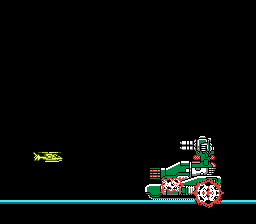
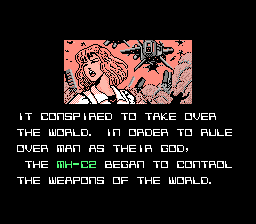
Defeating the bosses was always the most exciting part, as they’d explode for several seconds before finally biting the dust. Every time we beat one, my dad and I would just yell at the screen, “Take that and that and that and that and that aaaand THAT!” Although we never beat the game, we always took pride in watching those jerks suffer our combined wrath, which was good enough.
It’s impossible to deny that at least a portion of my love for the NES is fueled by a kind of desire to just head back to the past, and Silk Worm is best representative of that bias. I like to believe I’m entirely self-aware of when my nostalgic chauvinism kicks in, but there are times where childhood biases do begin take hold beyond my awareness. Although I feel like this kind of appreciation can often sour good discussion when you’re not aware of it, I do sometimes really enjoy taking part in the whole culture of unabashed love for everything old and Nintendo-related.
– – – – – – – – – – – – – – – – – – – – – – – – – – – – – – – – – – – – – – – – – – – – – – – – –
Jackal
Jackal is one of the NES games I have pretty much always loved in roughly equal, unwavering amounts. Even when I later came to judge games from a much more critical standpoint, it managed to stand against the tide with the best of them, my admiration for it only being tempered. Konami seriously brought the heat when it came to the NES, and I really think this was one of their very best games available.
Like both of the NES Contra games (Contra Force is not a Contra game), Jackal is a home console version of one of their arcade games that manages to not meet the quality of the original, but actually exceed it. Most arcade to NES conversions were phoned-in in or really toned down, but Jackal added an incredible amount of content, improved the controls and format of the game, and was even much more impressive from an aesthetic standpoint. It wasn’t as high resolution, but it had excellent overall composition.
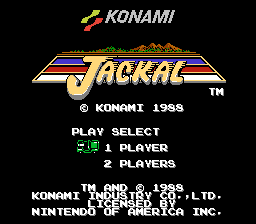
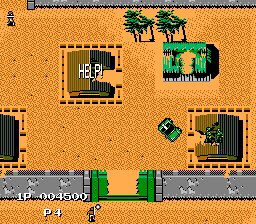
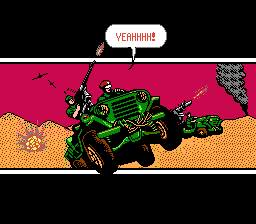
Although it doesn’t have the cult hit status that Contra does, it is a very quality game that I feel doesn’t come up in discussion over the NES quite as much as it should. My personal history with it goes way back to my uncle giving me his copy after finding that I enjoyed it a lot, and I’ve played it off and on since then.
I’ve always enjoyed hearing about personal memories people have with particular old games, particularly over sharing hints and tips, and one of my most memorable was my uncle warning me about this one building actually having a tank inside of it instead of the usual friendly P.O.W. you’d rescue for bonus points. When I blew it open and the tank rolled out, I couldn’t believe he was really telling the truth. It’s a really unexpected, cool little moment in the game that I’ve always remembered to be careful around, since then.
Today, there are a lot of games that are “like Jackal,” where you drive some sort of vehicle with an overhead view and shoot things up. They’re usually budget titles released on downloadable service, and generally tend to be lazy, pseudo-nostalgic cash-ins that really miss the point entirely when it comes to what made these classic games so well-designed. I always love to recommend Jackal to people, because as far as I’m concerned, it’s still better than anything else like it.
– – – – – – – – – – – – – – – – – – – – – – – – – – – – – – – – – – – – – – – – – – – – – – – – –
Super Mario Bros. 3
I don’t care who you are, it’s really hard to say you don’t consider Mario to be highly definitive of the NES, regardless of whether you think that’s for better or worse. As time has marched on, Super Mario Bros. 3 has come to arguably be considered the very best of the Mario games, and often considered the very best game available for the entire NES. While I don’t quite feel that strongly about it, it’s still one of my personal favorite games and is certainly very highly evocative of that era.
For a game on the NES made in 1988 (though it didn’t come out here until 1990), Super Mario Bros. 3 literally had no equal in terms of production values. It looks great, sounds great, and has a breadth of content hardly matched by any other platforming game available in that day. It went above and beyond most player’s expectations for a true Mario sequel, and many elements of the game remain highly iconic to this day.
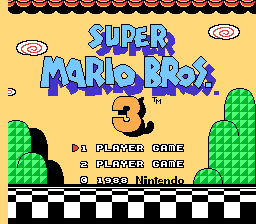
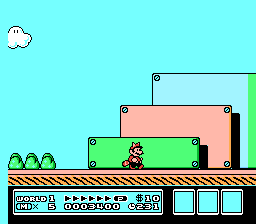
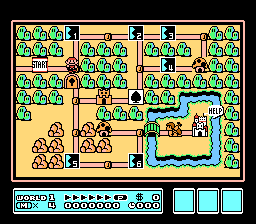
Sharing hints about things like how to get Tanuki or Hammer Mario, finding out you can drop behind the white blocks, using whistles for your first time and trying to beat the game by skipping most of it, knocking a goomba out of that shoe and taking a ride, discovering giant world for the first time – these are all commonly shared memories that people who fondly regard the NES tend to love to talk about. My experiences with it are hardly all that unique, but they’re still precious to me, and being able to share them with so many people is something I strongly appreciate.
While Mario shifted more and more toward “playground” style games and heavy brand recognition as big entries in the series were released, Super Mario Bros. 3 still retained the obstacle course/marathon-like feel of the original Super Mario Bros and a keen sense of innovation. The difficulty of the game begins rather scaled back, but picks up considerably toward the end to satisfy players still looking for a challenge, something I feel that modern Nintendo has almost entirely forgotten about.
– – – – – – – – – – – – – – – – – – – – – – – – – – – – – – – – – – – – – – – – – – – – – – – – –
Kirby’s Adventure
Remember earlier, when I mentioned that I returned my first copy of Bionic Commando to the pawn shop to get another game? Well, the game I returned it for was none other than Kirby’s Adventure. By this point, I’ve made it pretty clear that I really turned my opinion around on Bionic Commando, but I still harbor zero regret about the decision to have traded it in because I feel like its learning curve was something I just wasn’t prepared to get over, at that time.
Kirby’s Adventure, on the other hand, is an incredibly accessible game that was a perfect choice for me. Both the format of the game, with its big worlds divided up into bite-sized playgrounds with lots to do, and its presentation, which is full of brought colors, detailed animations and luscious background art, lean it heavily toward being one of the most stand-out titles available for the NES.
While its low difficulty can be considered a weakness (I was still stuck on Kracko for an embarrassingly long time as a kid), Kirby’s Adventure is less about the challenge in doing things and more about the sheer joy of just doing them. This lends itself to be a game I highly recommend to kids, but also a game I find myself still coming back to just to relax in. The attention to detail in Kirby’s visual design is hard to rival, and each portion of the game is divided up into such a digestible format that it’s hard to put down or really find it boring.
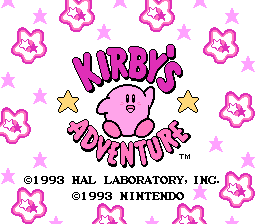
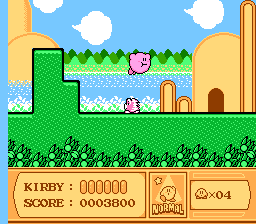
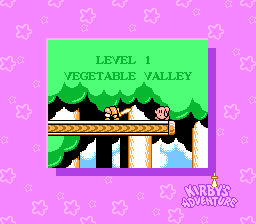
Kirby’s a big game, but it’s never oversaturated. Each foray into a new level feels like a unique sweet to savor, as opposed to modern platformer design, where each new level feels like a bite out of a gigantic, conglomerate mass of processed foods. You know, without even thinking about it, I’m turning my discussion about the game into food metaphors – Kirby’s Adventure’s theming is just so well done, your subconscious can’t help but be fixated on it just when you hear the name.
The game does a good job of embodying this quaint, simple entertainment value that quite a few NES games possessed before becoming nauseatingly corrupted by branding and cut & paste design. Kirby’s Adventure almost perfectly captures that notion of “the good ol’ days” of gaming, in perhaps what has become a somewhat depressing way given how far gone modern Kirby design seems to be in terms of understanding what once made Kirby so good.
– – – – – – – – – – – – – – – – – – – – – – – – – – – – – – – – – – – – – – – – – – – – – – – – –
Super Mario Bros.
I do consider the third entry the better game, but my history with the original is that much richer, and my admiration of its icons that much more significant. The coin’s glow and sound effect, Mario’s look and physics, the jumps to the flagpoles and the slide down them while you hope for the fireworks to activate when you walk in the castle… Nearly every component of Super Mario Bros., from how it looks and sounds to how it plays, is something I find rich with memories.
Being my first video game certainly plays a role in my appreciation, but I feel like it really runs a lot deeper than simply discounting it as mere nostalgia. Bits and pieces from the game have become symbols of gaming culture, today, and they often remain exactly as they originally appeared, preserved in their original pixel art on all sorts of things in all sorts of places. When the NES strolled onto the scene and more or less saved the gaming hobby, Super Mario Bros. was the big game that everyone went to.
The ridiculous premise of a plumber saving a princess from an evil turtle/dragon in a kingdom full of mushrooms has forever and irreversibly shaped what people think of when someone says “video game.” Beyond being an excellently designed, obstacle course of a game that influenced countless platformers, what Super Mario Bros. more importantly did was unleash the imaginations of millions of people.

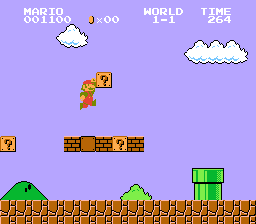

I feel like the NES still stands out as the gaming console that has both showcased and encouraged the greatest amount of creativity, and the original Super Mario Bros. is the game that best defines Nintendo’s once great ambitions to really push those boundaries. What Mario has become today is more or less cynical and even depressing given his roots, but nothing can retroactively rob him of all the good I strongly feel he once stood for.
I still have so many fond memories of playing Super Mario Bros. with my mother and father. Although mom rarely ever played games with us, we’d always end up calling her to come help us beat the underwater levels. For some reason that neither me nor my father could understand, she could, with a pretty decent level of reliability, clear those stages considerably better than either of us. It’s the only game I can remember all of us sitting down to play together, and it never felt like I was forcing them to do it.
There’s something powerful to be said about a game that people almost universally go back to, either to play or to borrow from. Every time people want to see weird Game Genie codes, the first game they go to see what people have done something with is Super Mario Bros. When corrupting ROMs became a fad, it was the same story. There have been countless ROMhacks and fanmade games based all around the original, and it’s not just because of the circumstances that led so many people to playing it, but because it is a succint, beautiful game.
– – – – – – – – – – – – – – – – – – – – – – – – – – – – – – – – – – – – – – – – – – – – – – – – –
Mega Man 2
It’s hard to follow something up with as much flattery as I just gave Super Mario Bros., but I was always a Mega Man kinda gal. I’d put blue cups over my hand and pretend I had a Mega Buster, I had a Mega Man birthday cake, I’d always talk about Mega Man every time I got the chance at the lunch table, I bought my Super Nintendo for Mega Man X and my PlayStation for Mega Man “Neo,” et cetera. I think it’s disgusting to identify as a “fangirl” of anything, but let’s just say that the blue bomber occupies a place close to my heart.
It all, of course, started with Mega Man 2. I saw that guy with his laser pistol on the cover and his blue outfit, and for some reason, I just had to rent it. Nearly instantly, I was in love with the game. Everything about it felt right and I couldn’t put it down. For years afterward, I would rent a different Mega Man from the rental place (slash tanning station) each weekend, always playing them over and over again and absorbing every detail from how the little guy would take a power at the end of a stage to how the charge shot looked differently or was absent from this or that entry.
Mega Man 2 was easily the one I continued to rent the most, and one of only two (the other already mentioned) that I would buy as an NES cartridge before becoming a young adult. Yeah, you couldn’t charge your Mega Buster (for some reason I was happy enough having anything to charge, and you did have Heat Man’s weapon for that), and sure, you couldn’t slide, but I think some small part of my mind recognized even from a young age that despite the absence of those mechanics, the game had been much more masterfully crafted than any other entry in the series.
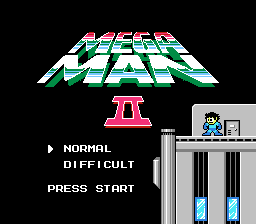
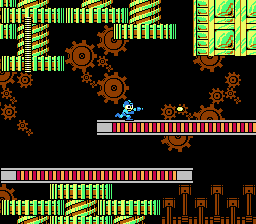
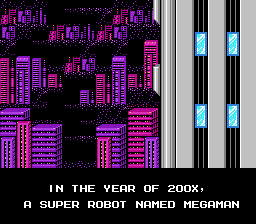
To this day, it is widely hailed not only as one of the best NES games, but as one of the best games of all time. Everything about Mega Man 2 is given such attention that it’s hard for any part of it to not leave a lasting impression on the player. What perhaps helped make Mega Man 2 stand out so much above the crowd was how you were given the choice of 8 levels to pick from, and each of them were themed around the robot master “boss” that you’d fight at the end.
I really feel it’s one of the most important, early games in playing up the importance of the boss fight and establishing the mini-marathon format of level design with the boss at the end. Mega Man 2 introduced new elements in controlled environments, asked you to adapt to them quickly, put you to the test on making sure you knew them, and then pitted you against the boss at the end as the level’s greatest hurdle. What really brought each level together was how it was themed around the robot master at the end, and it made each time you beat a level a miniature victory to celebrate.
While the first game was the one to introduce the formula – and I don’t mean to diminish it simple, but elegant design – its sequel, Mega Man 2, is what really made Mega Man stand out and is what truly cemented it as a significant part of video game culture. 2 was popular enough that it reignited enough interest in the first to get it reprinted, and the legacy that Mega Man 2 left is one of the most storied you’ll find in all of gaming.
– – – – – – – – – – – – – – – – – – – – – – – – – – – – – – – – – – – – – – – – – – – – – – – – –
Contra
Man, Contra is just the perfect NES game, to me. Not just in terms of being iconic of the NES, but in being my very favorite game available for the entire console. It’s an excellently designed run ‘n gun with an incredibly accessible difficulty curve and length. It’s tough, at first, but in sitting down with it for just a few hours, I feel there are few other games where your progression in mastering it feels more tangible.
It’s a great game to watch yourself get better playing, and its difficulty level is manageable enough that it never really gets out of hand. The way that Contra pushes its player forward with a keen sense of momentum is comparable to your mother or father letting go of you as you learn how to ride a bike. If you fall over, it’s your fault because you stopped peddling. Contra aggressively teaches players not to dawdle and to roll with mistakes – I could gush for hours about how I feel just the waterfall stage does this in an amazingly clever fashion.
Contra’s lessons are ones you never really “unlearn,” and once you’ve finally gotten the hang of them, you realize they weren’t ever really that challenging, to begin with. I feel like Contra has retroactively had this “massively difficult” label applied to it simply because of people becoming used to modern standards (and chumps that never weened themselves off of “the code”). I really stand by my guns when I say it’s a relatively easy game in the NES library, and one of the simplest to master – I suppose people are just so intimidated by one-hit deaths and running out of continues that they’re afraid to really try something.
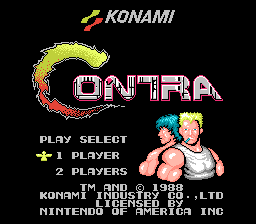
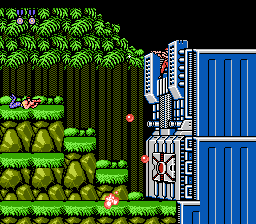
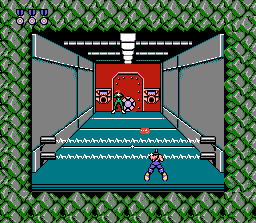
Over the years, Contra games have become a comfort food to me. Aside from a few dodgy releases, I always come back to a “Contra” over and over again, and the original NES game is easily the one I pop back in most frequently. Its short length can occupy a huge variety of time slots, and seeing if I can nail another flawless run always keeps it just difficult enough to be engaging while still being a relaxing, breezy ride through somewhere familiar.
Contra’s simple premise of playing a ruff ‘n tumble bad dude out to kick some alien butt is timeless and simple, and the fact it clearly homages popular movies of the time (it’s clear from the box art that Bill is based off of Schwarzenegger’s appearance in Predator, and Lance is based off of Stallone’s “Rambo” character) really nails it as a pop culture piece of its era. The game has become very fondly regarded, with people still remembering things like the Konami code, that would give you 30 lives, and the first level’s theme, which is nearly instantly recognizable to most NES fans.
I grew up on Contra training wheels with both me and my dad playing it together using the code and the NES Advantage’s slow motion feature (which would just pause and unpause the game rapidly; we always used it on the snow level’s boss). It was one of the first games I ever beat (albeit illegitimately with the code), as well as one of the most played games of both my childhood and adulthood. With the training wheels long since popped off, Contra has stood as what is arguably the most important game in me having come back to appreciate classic gaming, and the most influential title in terms of developing my taste in all games.